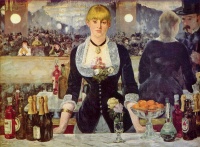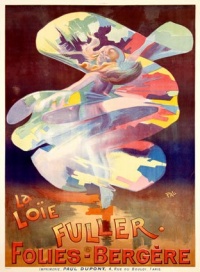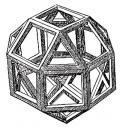Folies Bergère
From The Art and Popular Culture Encyclopedia

Illustration: A Bar at the Folies-Bergère by French painter Édouard Manet.

(poster by PAL (Jean de Paléologue), printed by Paul Dupont)

(Photo by Walery)
|
Related e |
|
Featured: |
The Folies Bergère is a Parisian music hall which was at the height of its fame and popularity from the 1890s through the 1920s. As of 2008 the institution is still in business. The Folies Bergère inspired the Ziegfeld Follies in the United States and other similar shows. One of its most popular representations, Édouard Manet's 1882 well-known painting A Bar at the Folies-Bergère depicts a bar-girl, one of the demimondaine, standing before a mirror.
Contents |
History
Located at 32 rue Richer, in the 9th Arondissement, it was built as an opera house by the architect Plumeret. It was patterned after the Alhambra music hall in London.
It opened on 2 May 1869 as the Folies Trévise, with fare including operettas, comic opera, popular song, and gymnastics.
The name was the word "folies", derived from the Latin word for "leaves" (foliae), connoting the idea of an outdoors entertainment venue, combined with the name of one of the adjacent streets, the "rue Trevise". (It was on the intersection of the rue Richter and the rue Trevise.) Unfortunately, the Duc de Trevise, a prominent nobleman, did not want people to think that he was associated with a bawdy dance hall. As a result, it was renamed the Folies Bergère on 13 September 1872, after another nearby street, the rue Bergère.
Édouard Manet's 1882 well-known painting A Bar at the Folies-Bergère depicts a bar-girl, one of the demimondaine, standing before a mirror.
The Folies Bergère catered to popular taste. Shows featured elaborate costumes; the women's were frequently revealing, and shows often contained a good deal of nudity. Shows also played up the "exoticness" of persons and things from other cultures, obliging the Parisian fascination with "négritude" of the 1920s.
Notable performers
In the early 1890s, the American dancer Loie Fuller starred at the Folies Bergères. Nearly thirty years later, Josephine Baker, an African-American expatriate singer, dancer, and entertainer, became an "overnight sensation" at the Folies Bergère in 1926 with her suggestive "banana dance", in which she wore a skirt made of bananas (and little else).
Other notable Folies Bergères performers have included singers Maurice Chevalier and Louisa Baileche, and comedian Cantinflas.
Similar venues
The Folies Bergère inspired the Ziegfeld Follies in the United States and other similar shows, including a long-standing revue, the Las Vegas Folies Bergere, at the Tropicana Resort & Casino in Las Vegas and the Teatro Follies in Mexico.
In the 1930s and '40s the impresario Clifford C. Fischer staged several Folies Bergere productions in the United States. These included the Folies Bergère of 1939 at the Broadway Theater in New York and the Folies Bergère of 1944 at the Winterland Ballroom in San Francisco.
The Las Vegas Folies Bergere, which opened in 1959, closed at the end of March 2009 after nearly 50 years in operation.
See also

